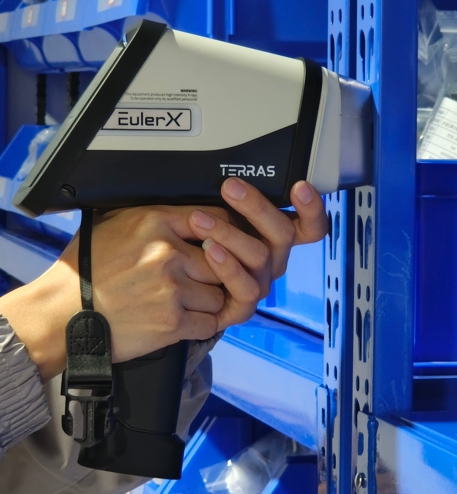
XRF Technology
A high-tech enterprise focusing on the development and application of X-ray technology products, committed to becoming a leading supplier of X-ray industrial testing solutions.
The Future of Elemental Analysis: Advancements in Handheld XRF Technology
In recent years, the landscape of elemental analysis has undergone a dramatic shift, driven by advances in technology that have made scientific tools more efficient, portable, and accessible. One such advancement is in handheld X-ray fluorescence (XRF) technology, which has revolutionized the way we analyze materials in a wide range of industries. From mining to environmental monitoring, and from archaeology to quality control, handheld XRF devices have opened new possibilities for on-site, real-time analysis. As we look to the future, it’s clear that the evolution of handheld XRF technology will continue to reshape how we approach elemental analysis, offering improved accuracy, greater versatility, and expanded applications.
What is Handheld XRF Technology?
X-ray fluorescence (XRF) is a non-destructive analytical technique used to determine the elemental composition of a sample. By bombarding a material with high-energy X-rays, the elements within the material emit fluorescent X-rays that can be measured to identify and quantify the elements present. Historically, XRF required large, stationary machines that were confined to laboratories. However, with advancements in miniaturization, modern handheld XRF analyzers have made this powerful technology portable, affordable, and easy to use in the field.

Terras EulerX900 Handheld Alloy Analyzer
Advancements Driving the Future of Handheld XRF
Several technological advancements are pushing handheld XRF devices to new heights, improving their performance, user experience, and range of applications. Below are some of the most significant developments shaping the future of handheld XRF technology.
1. Improved Sensitivity and Detection Limits
One of the primary areas of development for handheld XRF devices is in increasing sensitivity and lowering detection limits. Advances in detector technology, such as silicon drift detectors (SDDs), have greatly enhanced the ability of handheld devices to detect trace elements with greater accuracy. The improved sensitivity allows for the analysis of samples at lower concentrations, which is especially valuable in industries such as environmental monitoring, where detecting contaminants in low concentrations is crucial.
2. Wider Elemental Coverage
Early handheld XRF devices were limited in the number of elements they could analyze, primarily focusing on heavy metals and simple materials. However, with the latest advancements, newer devices are capable of detecting a broader spectrum of elements, from light elements like carbon, oxygen, and nitrogen, to heavier metals like gold, lead, and mercury.
3. Enhanced Portability and Durability
As with any portable tool, the physical characteristics of handheld XRF devices are crucial for their widespread adoption. Modern handheld XRF analyzers are increasingly lightweight, ergonomic, and designed for rugged environments. Manufacturers are incorporating durable materials, such as reinforced plastics and impact-resistant screens, ensuring that devices can withstand harsh conditions in the field.
4. Real-Time Data Processing and Reporting
One of the most significant advantages of handheld XRF technology is the ability to obtain real-time results. This feature is becoming even more sophisticated with advancements in processing power and user interfaces. With improved data analytics and reporting capabilities, modern handheld XRF devices can provide instant, on-site feedback, helping users make informed decisions quickly.
Key Applications of Advanced Handheld XRF Technology
As handheld XRF technology continues to evolve, its range of applications expands across multiple industries. Below are some areas where the future of handheld XRF is already making a significant impact:
1. Environmental Monitoring
Handheld XRF devices are increasingly used in environmental monitoring to detect pollutants and contaminants in soil, water, and air. As regulations on hazardous materials become stricter, the ability to perform on-site analysis of environmental samples in real-time becomes an invaluable tool. From detecting lead in soil to analyzing water for heavy metals, handheld XRF technology allows for more proactive monitoring and faster remediation decisions.
2. Mining and Exploration
In the mining industry, handheld XRF devices are used for on-site analysis of ore samples to determine the mineral content, identify valuable metals, and assess the quality of materials. With enhanced detection limits and broader elemental coverage, mining companies can make quicker decisions regarding extraction and refining processes, improving operational efficiency and reducing costs.

Terras EulerX900 Handheld Alloy Analyzer
3. Quality Control in Manufacturing
For manufacturers, handheld XRF devices offer an efficient way to test raw materials and finished products for consistency and compliance with quality standards. Whether for checking the composition of alloys or ensuring the purity of materials in pharmaceutical production, the ability to conduct real-time quality control helps to reduce defects, minimize waste, and improve product reliability.
The EulerX 900 series has proved to be an excellent choice for metal analysis in a wide fields, providing fast, accurate results directly to the user. Thanks to its cutting-edge electronics and sophisticated mathematical algorithms, the EulerX 900 series ensures superior measurement quality within seconds. This makes it an ideal tool for inspecting and analyzing incoming materials, finished products, and in-process production parts in a non-destructive manner. Its simplicity of operation allows users to quickly view alloy grade and chemical composition on the touch screen display, achieving laboratory-quality analysis with minimal training and virtually no need for sample preparation, regardless of the sample is shape or size.
In conclusion, the future of handheld XRF technology is bright, with exciting advancements that will continue to push the boundaries of what’s possible in elemental analysis. Whether in the field, the factory, or the lab, the continued growth of this technology promises to revolutionize industries, streamline processes, and improve the precision and speed of material testing across the globe. As innovation continues to unfold, the next generation of handheld XRF devices will undoubtedly play a critical role in shaping the future of scientific and industrial.
Join Us
Subscribe to our email list for updates & promotions.



